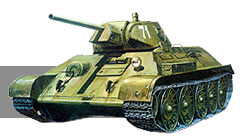


- V_P
- ebafoxxy
- 2 members
- 26 guests
- 4 robots
Visitors
| Today: | 2202 |
| Yesterday: | 2366 |
| This Week: | 11306 |
| Last Week: | 15730 |
| This Month: | 11306 |
| Last Month: | 55262 |
| Total: | 119224 |
T-43 Experimental Tank |
 |
 |
Created Tuesday, 20 September 2005 21:55
|
||||
Last Updated on Saturday, 09 January 2010 14:52
|
||||
|
By the middle of the war it had become clear that the Red Army did need a new medium tank. The military demanded a tank with maximum protection and minimum weight at the same time. These demands were implemented and the new medium tank project was completed by June The T-43 had a configuration like the T-34 Medium Tank, it's glacis consisted of Beginning in March 1943, two T-43 prototypes (preceded by vehicle T-43-1, which was built at the end of 1942. It possessed a driver's vision hatch, and had the commander's cupola displaced to the rear of the turret.) underwent trials. These included combat trials with the NKSM Independent Tank Company. These showed that the T-43, because of its increased 34.1 ton weight, was marginally inferior to the T-34 in its ability to maneuver (maximum speed was decreased to The armor protection was superior, compaired to the T-34, while it's armament was similar with the KV-1S Heavy Tank. However, the T-43 had a ground pressure like heavy tanks that adversely affected it's range and passability, but even worse was it's extreme construction, i.e. it didn't allow further modernisation. So, when production T-34's were rearmed with the Sources:
|
You need to login or register to post comments.
Add your comment. (total 0 comments)
© THE RUSSIAN BATTLEFIELD, 1998-2009




